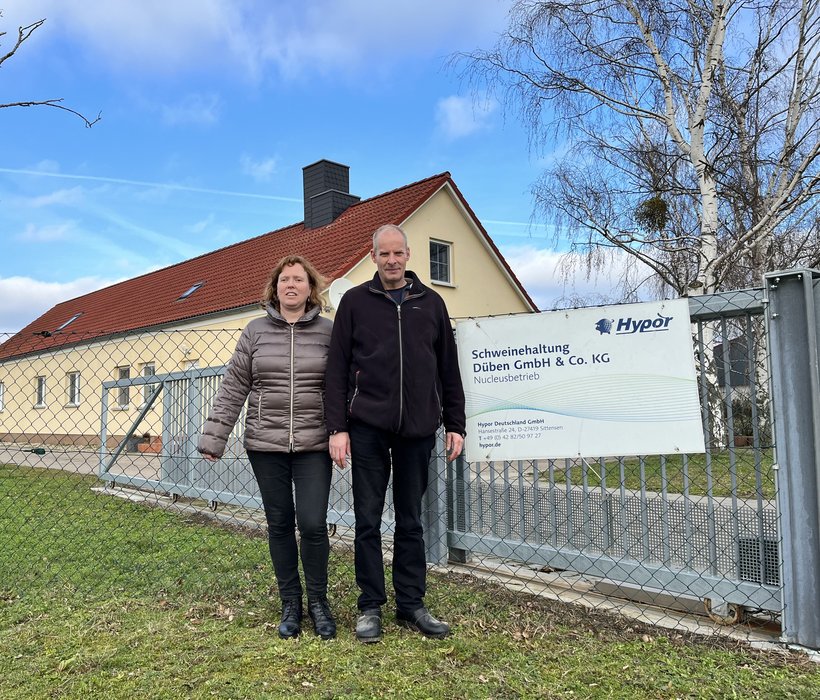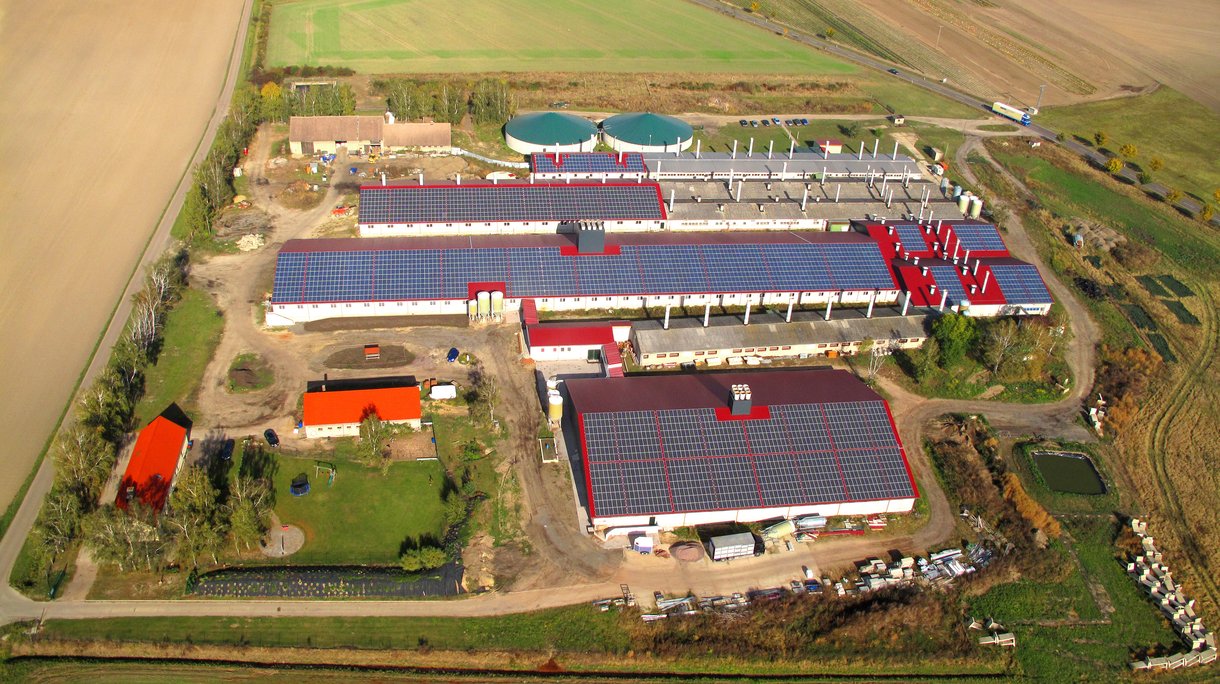
Published on May 4, 2023
"We want to provide sows that farrow easily": A Hypor customer success story
Leon and Lianne van Dijck run a GP and GGP nucleus farm in Germany with 2,500 sows plus 6,800 purebred and F1 gilts spread over two locations. With Hypor sow lines, the farm produces high-quality breeding gilts as well as robust, healthy piglets. This allows the Van Dijck family to maintain high-health status and optimize farm labor.
This article was originally published in “Varkensbedrijf” magazine and has been republished here with permission.
About twenty years ago, Leon and Lianne van Dijck settled on a former state-owned farm in eastern Germany. Over the years, the farm has expanded to 2,500 sows and 6,800 rearing sows spread over two locations. Their enterprise Schweinehaltung Düben is a nucleus farm with GGP and GP sow lines from Hypor. The F1 gilts go to multipliers throughout Europe. Around 25 percent are produced as pure lines. The farm is fully SPF (Specific Pathogen Free) and pays great attention to farrowing ability and healthy piglets.
Leon van Dijck owned a pig farm in the Netherlands in the past. But the possibilities for expansion were limited, and Leon began to feel the entrepreneurial itch. The pig farmers looked emphatically at opportunities across the border. "I wanted to go to America, but my wife didn't want that. I myself initially had no appetite for East Germany. But that's what we ended up doing and it was a good move," says Leon van Dijck. The pig farmers settled in Düben, a town in former East Germany. On a former state-owned farm, they started with 800 sows. "Staffing was not a problem then. Unfortunately, that is different now. Manure disposal was also not a problem. Nor is it now, by the way. Our neighbor and another crop farmer come and collect it for free," Van Dijck says.

Robust sow - healthy piglets
In 2009 and 2010, the pig farmers expanded the farm significantly. New barns were built at the home location for 2,500 sows and 3,200 rearing sows. From the beginning, Van Dijck chose to set up the farm as entirely SPF. For this, Hypor sows were purchased from Spain. Upon departure from Spain, blood was drawn from each animal, tested, and then examined again upon arrival in Düben. 50% of the purchased animals were landrace and 50% large white sows. After working with these for several years, Van Dijck switched to one hundred percent Large White.

These are pleasant, easy sows, with good feet and legs and good mothering abilities. They raise many piglets easily.
F1 gilts produced by Van Dijck depart at a weight of 25 kilograms to their own rearing location about fifty kilometers away or to one of the three permanent rearing companies Van Dijck works with. At an age of 180 to 200 days, they are sent to breeders throughout Europe. In addition to F1 breeding gilts, the company also produces pure line breeding gilts. These leave at 180 days of age. In addition, 700 to 800 pure line boars are raised annually, of which about ten usually end up at an AI station after a strict selection.

Keeping pigs healthy
The farm is free of Mycoplasma Hyo, APP, PRRS, dysentery and scabies. Leon van Dijck does everything possible to prevent the introduction of animal diseases. In this regard, it makes a huge difference that the farm is in an area with few pigs. "When we started building there was no other pig farm up to ten kilometers in the circumference. Since then, this circle has become even larger. Now there is no other pig farm within 25 kilometers," says the pig farmer. The only other pigs to be found around Düben are wild pigs. "I am not afraid of the wild pigs transmitting diseases to ours. We have very strict hygiene measures, and I trust that." Van Dijck's farm is completely fenced off, so wild pigs cannot get to the edge of the farm.
Visitors, such as the veterinarians or representatives from Hypor, are not allowed to have been around pigs for at least 72 hours guaranteed. Therefore, visitors are welcome only on Mondays to allow for a weekend gap. Anyone entering the farm must shower and put on company clothes. Items such as food and phones go into a UV cabinet. Additionally, when loading pigs, strict supervision is taken to ensure that no pigs go back into the barn. Once a pig has been outside, it is not allowed back in.
Every Monday, two or three climate-controlled Hypor trucks transport breeding stock from Van Dijck to the GDUs. The in-house remote rearing location and the other GDUs Van Dijck works with are also all SPF. Van Dijck says he notices the benefit of the high health status in the barn very well. "You don't hear a pig coughing," he says. "We also get positive stories back from our customers. Growth is better and less medication is needed. That's important at a time when we want to reduce antibiotic use."
Collecting data
The work on the farm is done by Leon and Lianne in collaboration with eighteen employees. Their fourteen-year-old son also helps out regularly. "Together we produce the best breeding gilts, which produce easy and healthy offspring. With this we want to lay the foundation for robust and healthy pigs. Our work is very protocol-based, and we collect a lot of data. For example, we want to know the birth weight of every piglet on the pure line." This is all stored in Hypor's MiXBLUP program that is used for breeding value estimation. “We also immediately count the teats. F1 gilts must have a minimum of fourteen teats. Pure line gilts at least fifteen. However, we hardly ever drop any animals because of too few teats,” said Van Dijck. “As soon as they go to rearing, they are weighed again to determine what the growth has been. The piglets are weighed on day 14 to determine the milk capacity and mothering characteristics of the sow. In the rearing pen, the gilts are weighed again. On day 180, the final selection takes place. This is done based on fat thickness, muscle thickness, conformation, achieved growth and conformation," Van Dijck explains.

The importance of farrowing ability
Van Dijck produces sows that are self-sufficient and that farrow easily. "That's important for the sow, but certainly also for the sow farmer. It's hard to find staff these days, so you have to make it easy for yourself in the farrowing house where you can. To provide sows that farrow easily, we don't help our pure line sows in farrowing, or at least as little as possible. We breed sows in this way who bond quickly with their piglets and are self-reliant.” Artificial milk is not provided on Van Dijck's farm. "If you keep the condition of the sows good by feeding them well, you don't have to make many adjustments in the farrowing house," is the pig farmer's experience. The sows on the Düben farm have an average of 16 piglets per litter, of which 14.9 are born alive. Birth weight averages 1.4 kilograms. On average, 13.8 piglets are weaned per litter. With this, Van Dijck is approaching Hypor's breeding goal of sixteen piglets born per litter, fifteen born alive, and fourteen weaned. "We had an average of 34 weaned piglets per sow last year," says the pig farmer proudly. It's a matter of selecting well and taking good care of the animals. If you are good to the pigs, they are good to you," Van Dijck concludes.

